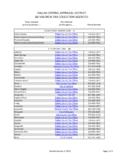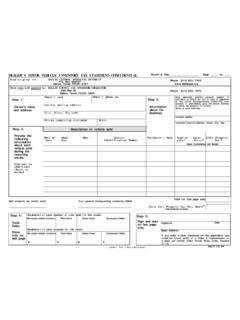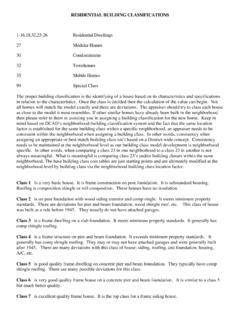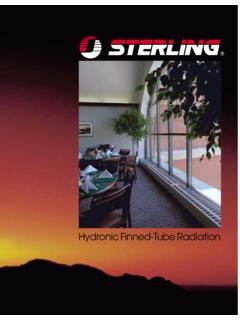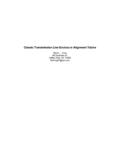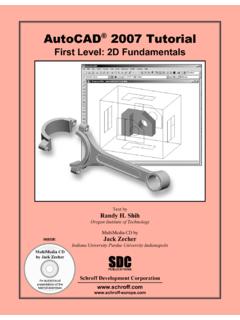Transcription of RESIDENTIAL BUILDING CLASSIFICATIONS - …
1 RESIDENTIAL BUILDING CLASSIFICATIONS . 1-16,18,32,23-26 RESIDENTIAL Dwellings 27 Modular Homes 30 Condominiums 32 Townhomes 35 Mobile Homes 99 Special Class The proper BUILDING classification is the identifying of a house based on its characteristics and specifications in relation to the characteristics. Once the class is decided then the calculation of the value can begin. Not all homes will match the model exactly and there are deviations. The appraiser should try to class each house as close to the model it most resembles. If other similar homes have already been built in the neighborhood then please refer to them in assisting you in assigning a BUILDING classification for the new home. Keep in mind based on DCAD's neighborhood- BUILDING classification system and the fact that the same location factor is established for the same BUILDING class within a specific neighborhood, an appraiser needs to be consistent within the neighborhood when assigning a BUILDING class.
2 In other words, consistency when assigning an appropriate or best match BUILDING class isn't based on a District-wide concept. Consistency needs to be maintained at the neighborhood level as our BUILDING class model development is neighborhood specific. In other words, when comparing a class 23 in one neighborhood to a class 23 in another is not always meaningful. What is meaningful is comparing class 23's and/or BUILDING classes within the same neighborhood. The base BUILDING class cost tables are just starting points and are ultimately modified at the neighborhood level by BUILDING class via the neighborhood BUILDING class location factor. Class 1 Is a very basic house. It is frame construction on post foundation. It is substandard housing. Roofing is composition shingle or roll composition.
3 These houses have no insulation. Class 2 is on post foundation with wood siding exterior and comp single. It meets minimum property standards. There are deviations for pier and beam foundation, wood shingle roof, etc. This class of house was built as a rule before 1945. They usually do not have attached garages. Class 3 is a frame dwelling on a slab foundation. It meets minimum property standards. It generally has comp shingle roofing. Class 4 is a frame structure on pier and beam foundation. It exceeds minimum property standards. It generally has comp shingle roofing. They may or may not have attached garages and were generally built after 1945. There are many deviations with this class of house; siding, roofing, and foundation, heating, A/C, etc. Class 5 is good quality frame dwelling on concrete pier and beam foundation.
4 They typically have comp shingle roofing. There are many possible deviations for this class. Class 6 is very good quality frame house on a concrete pier and beam foundation. It is similar to a class 5. but much better quality. Class 7 is excellent quality frame house. It is the top class for a frame siding house. Class 8 is an old style brick veneer house built on a pier and beam foundation. It meets minimum property standards. It has comp shingle roofing. There are a few deviations such as wood shingle roof, stone veneer, etc. Class 9 is an old style brick veneer house which is of good quality. Similar to class 8 in age but better quality and more gingerbread. The classic class 9 house has a steep gable roof. It is built on concrete pier and beam foundation. There are several deviations for the various components.
5 Class 10 is a old style, very good quality brick veneer house built on a concrete pier and beam foundation. They typically have clay tile roofing. There are several deviations such as exterior walls can be stone veneer. Class 11 is a solid masonry dwelling on a concrete slab foundation. It meets minimum standards. Class 12 is a brick veneer on a concrete pier and beam foundation. It slightly exceeds minimum property standards. It is similar to a class 8 but is not old style. Class 13 is a brick veneer house on a concrete pier and beam foundation. It is average quality. It typically has comp shingles. Most commonly built from about 1945 through the mid 1960's. Class 14 is brick veneer on a concrete slab foundation. It is of average quality and typically has a comp shingle roof. Tract homes are class 14's.
6 They typically have 2 bathrooms. They were built in the early 1960's to present date. Class 15 is a good quality brick veneer house. They are similar to a class 13 but are better quality. They are on pier and beam foundations. They were built in the late 1940's to the mid 1960's. Class 16 is a brick veneer on a concrete slab. It is a better than average construction house. It is a better quality class 14. Class 18 is a brick veneer good quality house. It is a step up from the class 16 house. It is a new version of a class 15. It is typically a comp single roof house built on a slab foundation. It has a deviation for a pier and beam foundation. Class 21 is a very good quality custom brick veneer house. It is better quality than a class 15 or class 18. It will have wood shingle or better quality comp shingle roof.
7 3 or more baths is the norm. It can be on a slab or pier and beam foundation. Class 23 is a superior quality custom house. It will have 4 or more bathrooms. It will have custom touches throughout the house. IT will typically have a large garage. Class 24 is an excellent quality, elaborate brick veneer house. Everything about this house is top grade. It is a step above a class 23. Class 25 is an excellent quality older style brick veneer house. Typically built before 1950. In it's day and time it was about the best house there was. Class 26 is the absolute best house made. They are of the finest quality and most elaborate finish out that there is. They are unique and extremely custom from start to finish. They are estate properties. They have features such as heated floors, tennis courts, materials made special for only this house, imported specialty items, etc.
8 Modular Home (27) is a house that was built off site then transported to the BUILDING location for assembly. Usually it is built off site in sections then assembled at the desired site. Condominium (30) is ownership of an individual unit in a multifamily setting with a percentage ownership of the common areas. There will be many common walls between different units. It is basically ownership of air space because one does not own the land but a shared interest in the land. There is no base cost table in the system for condominiums. They are individually valued at the complex level. Unit size, view, location, level of finish-out and other amenities are taken into consideration when valuing units within a complex and/or neighborhood. They are typically valued using sales from the complex or a competing complex.
9 A. total price per square foot is then mass updated to arrive at an indicated market value. However, when appropriate they can also be valued via the Income Approach like an apartment complex. Sales information typically takes precedent over Income information. The filed Condominium Declaration is what is used to determine living area square footage and percentage of land associated with a given unit. In other words, measurement are not undertaken by DCAD in order to establish the living area square footage as this information is set forth in the Condominium Declaration itself. Town Home (32) is a RESIDENTIAL property where there is a least one shared common wall and the owner owns the land. There is no base cost table in the system to value townhouses like there is for class 1 through class 26.
10 These are typically valued on price per square foot basis. Unit size, view, location, level of finish- out and other amenities are also taken into consideration when valuing units within a complex and/or neighborhood. They are typically valued using sales from the complex or a competing complex and/or neighborhood. A total price per square foot is then mass updated to arrive at an indicated market value. Special (99) is a RESIDENTIAL structure that does not fit in any other classification . These situations may be caused by a number of factors such as special construction types, a variety of amenities. When using this class, extensive comments on the comments screen is mandatory. An example of this would be a barn that was converted into living quarters or some type of commercial structure that has been converted into a single- family residence.



